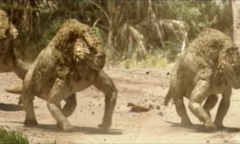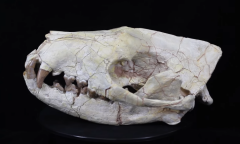By KM Diaz, | April 27, 2017

The bones of a mastodon found during the construction of California highway were unusually arranged beside a set of tools such as hammerstones and stone anvils. (YouTube)
In 1992, researchers found the bones of a mastodon - extinct elephant-like creature - butchered by mysterious species of early human. Now, researchers were able to identify that mastodon lived 130,000 years ago and early humans were also present in the United States during the same time.
Like Us on Facebook
The bones of a mastodon found during the construction of California highway were unusually arranged beside a set of tools such as hammerstones and stone anvils. But the researchers were not able to identify the date of the bones at that time.
Researchers used advanced uranium-thorium dating technique now to detect when the mastodon existed. The findings revealed that they survived 115,000 to 130,000 years before scientists believed humans first made it to the United States. The study was published in journal Nature.
The current theory of when and how early humans arrive in the United States is by Bering Land Bridge 15,000 years ago. The bridge connects North America and Siberia which scientists assumed that early humans have used as a route to move in the U.S. before it disappeared following the last Ice Age 12,000 years ago. The new study indicates that first humans in the U.S. arrive earlier than previously thought.
The bones and teeth of the mastodon found at the site were destroyed in a very specific way. The spiral fractures on the limb bones indicate it had been broken quickly before the animal died. The teeth also present some evidence that it was hit with hard objects. The researchers believe that the mastodon was butchered at the site based on the positioning of the bones and presence of the stone tools.
Thomas Deméré, the lead author of the study, says that they are not sure which species of hominin are responsible for the butchered bones because there are no human remains recovered in the site. However, they are convinced the humans existed in the U.S. 130,000 years ago.
But some scientists question the findings because of the absence of human remains. María Martinón-Torres, Lecturer in Paleoanthropology at UCL, U.K., says that it is too early to conclude the findings as there is no firm evidence that humans exist in the United States at the time. If it was Homo sapiens, there should be modern tools to properly cut the bones into pieces.
Meanwhile, according to Iain Morley, an academic coordinator at University of Oxford's School of Anthropology & Museum Ethnography, the authors of the study presents strong arguments that the damage on the bones of the mastodon was done by hominin activity.
If the interpretation of the researchers is correct, the mysterious species would be archaic human than modern Homo sapiens because there's no presence of Homo sapiens east of the Levant 130,000 years ago. The study authors welcome skepticism and invite other scholars to further analyze the evidence.
-
Use of Coronavirus Pandemic Drones Raises Privacy Concerns: Drones Spread Fear, Local Officials Say

-
Coronavirus Hampers The Delivery Of Lockheed Martin F-35 Stealth Fighters For 2020

-
Instagram Speeds Up Plans to Add Account Memorialization Feature Due to COVID-19 Deaths

-
NASA: Perseverance Plans to Bring 'Mars Rock' to Earth in 2031

-
600 Dead And 3,000 In The Hospital as Iranians Believed Drinking High-Concentrations of Alcohol Can Cure The Coronavirus

-
600 Dead And 3,000 In The Hospital as Iranians Believed Drinking High-Concentrations of Alcohol Can Cure The Coronavirus

-
COVID-19: Doctors, Nurses Use Virtual Reality to Learn New Skills in Treating Coronavirus Patients












